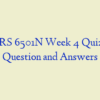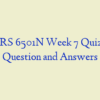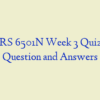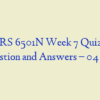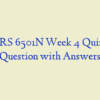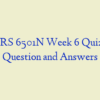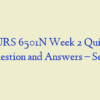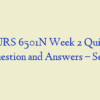Description
NURS 6501N Week 8 Quiz – Advanced Pathophysiology Spring Term
- A 24-year-old male who sustained a head injury and fractured femur develop a stress ulcer. A common clinical manifestation of this ulcer is:
- A 54-year-old male is diagnosed with peptic ulcer disease. This condition is most likely caused by:
- A 45-year-old male complains of heartburn after eating and difficulty swallowing. He probably has:
- A 60-year-old male is diagnosed with cancer of the esophagus. Which of the following factors most likely contributed to his disease?
- A 27-year-old male presents with fever, GI bleeding, hepatomegaly, and transient joint pain. He reports that as a child he received blood transfusions following a motor vehicle accident. He also indicates he was vaccinated against hepatitis B. Which of the following types of hepatitis does the clinician think he most likely has?
- The cardinal signs of small bowel obstruction are:
- Early identification and treatment for metabolic disorders is important because:
- The cardinal sign of pyloric stenosis caused by ulceration or tumors is:
- The exocrine portion of the pancreas contains:
- Manifestations associated with hepatic encephalopathy from chronic liver disease are the result of:
- Reflux esophagitis is defined as a(n):
- A 55-year-old male died in a motor vehicle accident. An autopsy revealed an enlarged liver caused by fatty infiltration, testicular atrophy, and mild jaundice secondary to cirrhosis. The most likely cause of his condition is:
- A 3-month-old female presents with intention tremors, dystonia, greenish-yellow rings in the cornea, and hepatomegaly. Tests reveal a defect on chromosome 13. Which of the following is the most likely diagnosis?
- A 40-year-old female presents complaining of pain near the midline in the epigastrium. Assuming the pain is caused by a stimulus acting on an abdominal organ, the pain felt is classified as:
- The primary complication of enterocolitis associated with Hirschsprung disease is related to which finding?
- Chronic gastritis is classified according to the: nurs 6501n week 8
- The nurse assessing the patient with biliary atresia would expect to find which primary clinical manifestation?
- A 3-month-old female develops colicky pain, abdominal distention, and diarrhea after drinking cow’s milk. The best explanation for her symptoms is:
- A 13-year-old female confides to her mother that she binge eats and induces vomiting to prevent weight gain. This disease is referred to as:
- Marasmus is most common in children of which age group?
- A 1-week-old female is brought to her pediatrician for abdominal distention and unstable temperature. Physical examination reveals bradycardia and apnea. Tests reveal hypoxic injury to the bowel resulting in bacterial invasion and perforation. This condition is referred to as:
- An 8-week-old male was recently diagnosed with cystic fibrosis. Which of the following digestive alterations would be expected?
- A 22-year-old male underwent brain surgery to remove a tumor. Following surgery, he experienced a peptic ulcer. His ulcer is referred to as a(n) _____ ulcer.
- A 16-year-old female presents with abdominal pain in the right lower quadrant. Physical examination reveals rebound tenderness and a low-grade fever. A possible diagnosis would be:
- Acute pancreatitis often manifests with pain to which of the following regions?
- For the patient experiencing esophageal reflux, the nurse would expect which sphincter to be malfunctioning?
- Kwashiorkor is a severe dietary deficiency of: nurs 6501n week 8
- In alcoholic cirrhosis, hepatocellular damage is caused by:
- A 6-month-old male infant is brought to the ER after the sudden development of abdominal pain, irritability and vomiting followed bypassing of “currant jelly” stool. Ultrasound reveals intestinal obstruction in which the ileum collapsed through the ileocecal valve and invaginated into the large intestine. This type of obstruction is referred to as:
- The most common clinical manifestation of portal hypertension is _____ bleeding.
- Which of the following characteristics is associated with acute occlusion of mesenteric blood flow to the small intestine?
- An 8-week-old female is diagnosed with congenital heart disease and Down syndrome. Her parents report that she has difficulty defecating. X-ray reveals anorectal malformation that causes complete obstruction often referred to as:
- A 20-year-old male was recently diagnosed with lactose intolerance. He eats an ice cream cone and develops diarrhea. His diarrhea can be classified as _____ diarrhea.
- The most common cause of chronic vascular insufficiency among the elderly is: nurs 6501n week 8
- When an infant has increased bilirubin production and impaired hepatic excretion of bilirubin, what does the nurse suspect is occurring in the patient?


